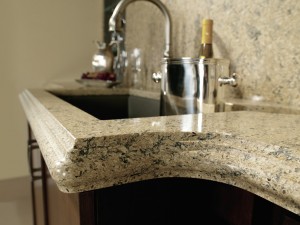Kitchen Countertops Cambria vs Granite
Countertops are subjected to scratches, stains and the stresses of everyday life. Cambria can meet both the needs of your lifestyle and the demands of your inspiration.
Cambria surfaces are 93% pure quartz. Granite typically only contains 40–60% quartz, along with more porous, weaker minerals. That’s why granite is more susceptible to damage.
Cambria’s durability also means you can be more creative with it.
Design daring edge shapes with wider overhangs to create
a kitchen like no other.
Cambria is made for those who truly love to cook. Because it’s nonporous and nonabsorbent, it won’t draw in moisture from raw or leftover food, which can harbor harmful bacteria. It gives off zero emissions, and no radon. There is no safer stone surface for food preparation, period.
Just use warm water and mild soap to clean. Unlike granite and marble, quartz doesn’t need periodic sealing, polishing or reconditioning. You won’t have to work with messy oils or dangerous chemicals—there’s no cost of upkeep for Cambria once it’s installed.


Comments